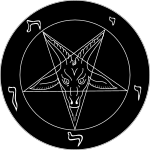
Back Kerk van Satan Afrikaans كنيسة الشيطان Arabic كنيسة الشيطان ARZ Şeytan kilsəsi Azerbaijani Църква на Сатаната Bulgarian চার্চ অব স্যাটান Bengali/Bangla Iliz Satan Breton Església de Satan Catalan Církev Satanova Czech Church of Satan Danish
This article may rely excessively on sources too closely associated with the subject, potentially preventing the article from being verifiable and neutral. (March 2022) |
| Church of Satan | |
|---|---|
 Sigil of Baphomet, an official symbol of LaVeyan Satanism[1] | |
| Abbreviation | CoS |
| Type | Satanism |
| Classification | New religious movement |
| Orientation | LaVeyan Satanism |
| Scripture | The Satanic Bible |
| Theology | Egotheism |
| Governance | Council of Nine |
| Structure | Cabal |
| High Priest | Peter H. Gilmore |
| Associations | Non-ecumenical |
| Region | International |
| Headquarters | Poughkeepsie, New York |
| Founder | Anton Szandor LaVey |
| Origin | April 30, 1966 Black House, San Francisco, California |
| Separations | Temple of Set (1975), First Satanic Church (1999) |
| Members | Not disclosed |
| Other name(s) | The Satanic Church |
| Publications | The Black Flame, The Cloven Hoof |
| Official website | www |
| Part of a series on |
| LaVeyan Satanism |
|---|
 |
| Organizations |
| Notable people |
| Texts |
| Media |
| Related Topics |
The Church of Satan (CoS) is a religious organization dedicated to the religion of Satanism as defined by Anton Szandor LaVey. Founded in San Francisco in 1966, by LaVey, it is considered the "oldest satanic religion in continual existence", and more importantly the most influential, inspiring "numerous imitator and breakaway groups".[2][Note 1] According to the Church, Satanism has been "codified" as "a religion and philosophy" by LaVey and his church.[4] Founded in an era when there was much public interest in the occult, witchcraft and Satanism, the church enjoyed a heyday for several years after its founding. Celebrities attended LaVey's satanic parties and he was invited on talk shows. His Satanic Bible sold nearly a million copies.[2][5]
LaVey was the church's High Priest until his death in 1997.[6] In 2001, Peter H. Gilmore was appointed to the position of high priest, and the church's headquarters were moved to Hell's Kitchen, Manhattan, New York City. Members do not believe that Satan literally exists and do not worship him.[7] Instead, Satan is viewed as a positive archetype embracing the Hebrew root of the word "Satan" as "adversary", who represents pride, carnality, and enlightenment, humanity's natural instincts which Abrahamic faiths have wrongly suppressed. According to High Priest Peter H. Gilmore, Satan is "a name for the reservoir of power inside each human to be tapped at will" .[6] In LaVey's book, The Satanic Bible, the Satanist's concept of a God is described as the Satanist's true "self"— a projection of his or her own personality, not an external deity.[8] Satan is used as a representation of personal liberty and individualism.[9]
The Church dismisses the idea of a “Satanic Community” and does not share membership lists with its members, arguing members are "radical individualists" who "may share very little in common beyond" being Satanists.[10] The Church rejects the legitimacy of any other organizations who claim to be Satanists.[11][12] Scholars agree that there is no reliably documented case of Satanic continuity prior to the founding of the Church of Satan.[13] It was the first organized church in modern times to be devoted to the figure of Satan,[14] and according to Faxneld and Petersen, the Church represented "the first public, highly visible, and long-lasting organization which propounded a coherent satanic discourse".[15]
- ^ Gilmore, Magus Peter H. "F.A.Q. Symbols and Symbolism". Church of Satan. Archived from the original on January 7, 2019. Retrieved April 4, 2017.
- ^ a b Laycock, Satanism, 2023: section 4. The Church of Satan
- ^ R. van Luijk, Children of Lucifer: The Origins of Modern Religious Satanism (New York: Oxford University Press, 2016), p. 305.
- ^ Ethan, Joel. "The Satanic Temple Fact Sheet". Church of Satan. Retrieved January 11, 2024.
- ^ Owen Davies, Grimoires: A History of Magic Books (Oxford: Oxford University Press, 2009), p. 274.
- ^ a b "Official Church of Satan Website". Churchofsatan.com. Archived from the original on July 1, 2012. Retrieved January 9, 2023.
- ^ Abrams, Joe (Spring 2006). Wyman, Kelly (ed.). "The Religious Movements Homepage Project - Satanism: An Introduction". virginia.edu. University of Virginia. Archived from the original on August 29, 2006. Retrieved January 1, 2021.
- ^ Wright 1993, p. 143.
- ^ Cavaglion & Sela-Shayovitz 2005, p. 255.
- ^ Gilmore, Peter H. "Myth of the 'Satanic Community' and other Virtual Delusions by Magus Peter H. Gilmore". Church of Satan. Retrieved January 7, 2024.
- ^ Ohlheiser, Abby (November 7, 2014). "The Church of Satan wants you to stop calling these 'devil worshiping' alleged murderers Satanists". The Washington Post. Retrieved November 19, 2015.
- ^ Wikinews:Satanism: An interview with Church of Satan High Priest Peter Gilmore
- ^ Asprem & Granholm 2014, p. 75.
- ^ Lewis 2002, p. 5.
- ^ Faxneld & Petersen 2013, p. 81.
Cite error: There are <ref group=Note> tags on this page, but the references will not show without a {{reflist|group=Note}} template (see the help page).